In today’s world, the role of technology is undeniable. It has transformed nearly every aspect of life, from communication to work. With 59% global internet penetration and an average daily screen time of 6 hours and 42 minutes, its influence is profound.
The COVID-19 pandemic accelerated this digital shift, pushing people to rely on technology for education, healthcare, and social interactions. While it has brought convenience and efficiency, it also raises concerns about mental health and social isolation.
Emerging innovations like artificial intelligence and virtual reality are shaping the future. These advancements promise to redefine how we interact with the world. Yet, they also bring challenges that need careful consideration.
This article explores the dual nature of technology’s impact, examining its benefits and drawbacks. From enhanced connectivity to environmental concerns, we’ll dive into its multifaceted role in modern society.
Introduction: The Pervasive Role of Technology in Modern Life
Modern life is deeply intertwined with the fabric of digital tools. From communication to work, these advancements have reshaped how we interact with the world. With over 4.57 billion internet users globally, digital technology has become a cornerstone of daily routines.
North America leads with a 95% internet penetration rate, while other regions are catching up rapidly. This widespread adoption highlights the growing reliance on digital solutions across the globe.
Smartphones play a central role in this transformation. On average, U.S. users interact with their devices 2,176 times daily. This constant engagement underscores the significance of mobile technology in modern life.
The COVID-19 pandemic accelerated the shift to virtual spaces. Platforms like Zoom saw a surge, reaching 800 million monthly users. This change not only altered workspaces but also redefined social interactions.
However, this digital revolution comes with challenges. The concept of “digital footprints” raises privacy concerns. As we navigate this new era, understanding the balance between convenience and security is crucial.
According to Nature Outlook, the digital revolution marks a shift from material and energy-based systems to information-driven paradigms. This transition is reshaping societal structures and individual behaviors.
| Region | Internet Penetration Rate |
|---|---|
| North America | 95% |
| Europe | 87% |
| Asia | 64% |
| Africa | 43% |
As digital technology continues to evolve, its impact on both neurological and societal levels becomes more apparent. This sets the stage for a deeper exploration of its dual-edged influence.
How Technology Affects People: A Dual-Edged Sword
The rapid evolution of digital systems has created a dual-edged impact. While these advancements offer convenience and efficiency, they also bring challenges that affect individuals on multiple levels.
The World Health Organization recommends limiting screen time to promote well-being. However, actual usage patterns often exceed these guidelines. Studies show that prolonged exposure can influence cognitive development, especially in younger individuals.
Research using fMRI and DTI scans reveals changes in brain structure due to digital engagement. Neuroplasticity, the brain’s ability to adapt, can be both a positive effect and a negative effect. While learning new skills is enhanced, overuse may lead to attention deficits.
The “screen time paradox” highlights a tradeoff between productivity and mental health. While digital tools boost efficiency, excessive use can lead to stress and burnout. Technostress, a term coined for the anxiety caused by constant connectivity, is increasingly common.
“The Cambridge Analytica scandal exposed the risks of social media, raising concerns about privacy and manipulation.”
Generational differences also play a role. Younger generations adapt quickly, while older individuals may struggle with the pace of change. This divide underscores the need for balanced adoption and education.
As we explore the impact of digital systems, it’s clear that their influence is multifaceted. From mental health to societal structures, understanding this duality is essential for navigating the future.
The Positive Effects of Technology on Communication
Digital advancements have revolutionized the way we connect and communicate. From personal chats to professional meetings, these tools have made interactions faster, easier, and more efficient. The rise of social media and other platforms has brought people closer, breaking down barriers that once limited global connectivity.
Breaking Down Barriers: Global Connectivity
One of the most significant impacts of digital tools is their ability to connect people across the globe. Video conferencing has seen a massive surge, with 16-24-year-olds in the UK spending an average of 34.3 hours per week on such platforms. Apps like WhatsApp have become essential for maintaining connections, especially for diaspora communities.
AI-powered translation tools are also breaking language barriers, making communication seamless across cultures. For example, tools like ChatGPT, which sees 1.8 billion monthly visits, are transforming how we interact in multilingual settings.
Enhancing Relationships: Social Media and Beyond
Social media use has redefined how we build and maintain relationships. Platforms like Facebook and Instagram allow users to stay connected with friends and family, no matter the distance. Niche platforms like Nextdoor foster community-building by connecting neighbors and local groups.
Virtual reality (VR) is another game-changer, offering immersive experiences for long-distance relationships. Couples separated by geography can now share virtual spaces, making distance feel less isolating.
In the professional world, tools like Slack and Microsoft Teams have streamlined workplace communication. These platforms support both synchronous and asynchronous interactions, enhancing productivity and collaboration.
“The pandemic-driven 400% increase in telehealth consultations highlights the versatility of digital tools in fostering connections.”
From personal bonds to professional networks, digital innovations continue to enhance the way we communicate. As these tools evolve, their potential to bring people together grows even further.
Technology’s Role in Education and Learning
The landscape of education has been reshaped by advancements in digital tools. From online courses to AI-powered systems, these innovations are transforming how we learn and access information. The pandemic accelerated this shift, with a 20% increase in MOOC enrollment, according to Tech.co.
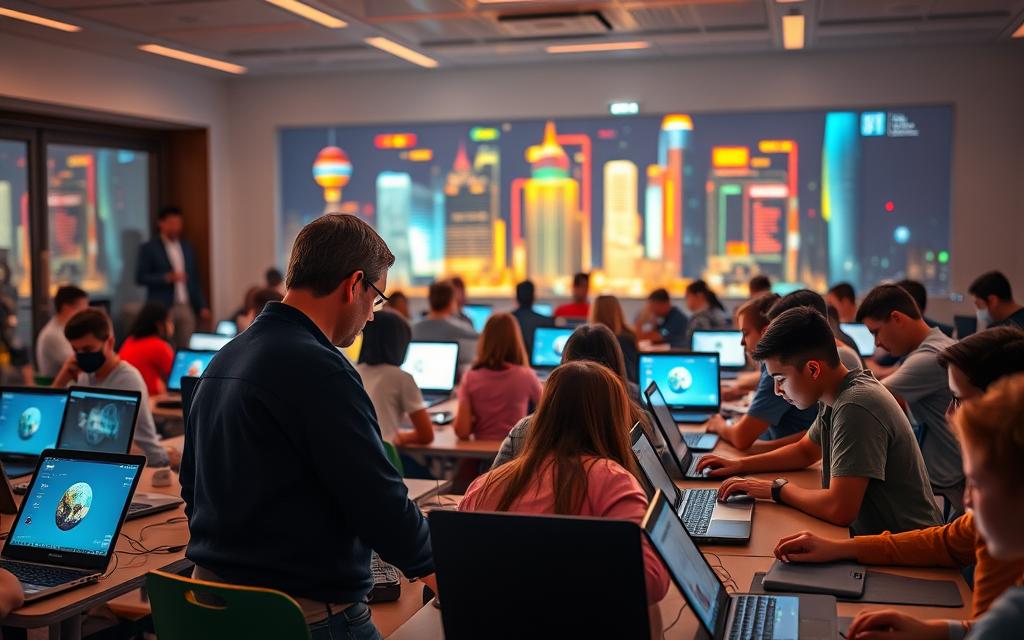
Online Learning Platforms: A New Era of Education
Platforms like Coursera and edX have gained popularity, offering certifications that rival traditional degrees. AI-powered adaptive learning systems personalize education, making it more effective. A Stanford study found that spaced repetition apps improve retention rates by up to 30%.
Augmented reality (AR) is also making waves, particularly in vocational training. Simulations powered by AR provide hands-on experience, bridging the gap between theory and practice. These advancements highlight the potential of digital tools to enhance learning outcomes.
Access to Information: The Knowledge Revolution
The internet has democratized access to information, but challenges remain. Wikipedia, for instance, has been shown to be as accurate as traditional encyclopedias in many cases. However, the digital divide persists, with only 39% internet penetration in Africa.
Blockchain-based credential systems are emerging as a solution for verifying educational achievements. These systems ensure transparency and security, addressing concerns about fraud. Yet, the abundance of information also raises issues of overload and source verification.
“The rise of online learning has made education more accessible, but it also demands critical thinking to navigate the vast sea of information.”
As we embrace these innovations, balancing accessibility with quality remains a key challenge. The future of education lies in leveraging platforms and digital tools to create inclusive, effective learning environments.
How Technology Has Improved Healthcare
Healthcare has seen transformative changes through innovative solutions. From remote consultations to real-time monitoring, advancements are enhancing patient care and accessibility. These developments are reshaping the industry, making it more efficient and inclusive.
Telemedicine: Bridging the Gap in Healthcare Access
Telemedicine has become a cornerstone of modern healthcare. During the pandemic, its use surged by 400%, according to Medical News Today. This shift allowed patients to consult doctors from home, reducing the need for in-person visits.
Remote patient monitoring systems have also cut costs significantly. These digital tools track vital signs and send data to healthcare providers in real-time. This approach improves care while minimizing hospital stays.
AI-powered diagnostic tools are another breakthrough. In trials, these systems have outperformed human radiologists in detecting conditions like cancer. This research highlights the potential of AI to revolutionize diagnostics.
Wearable Tech: Monitoring Health in Real-Time
Wearable devices are transforming how we manage our health. The FDA has approved numerous health monitoring wearables, from smartwatches to fitness trackers. These gadgets track everything from heart rate to sleep patterns.
Blockchain technology is enhancing the security of health data. It ensures that sensitive information is shared securely between patients and providers. This innovation addresses privacy concerns while improving care coordination.
3D printing is another game-changer. Custom prosthetics and organ models are now more accessible, thanks to this technology. These advancements are lowering costs and improving patient outcomes.
Smart pill bottles are boosting medication adherence. These devices remind patients to take their prescriptions, reducing missed doses. This innovation is particularly beneficial for managing chronic conditions.
“The integration of advanced tools in healthcare is not just about innovation—it’s about improving lives.”
As these technologies evolve, ethical considerations remain crucial. Genetic testing, for instance, raises questions about privacy and accessibility. Balancing innovation with responsibility is key to ensuring equitable health advancements.
For more insights on how digital tools are transforming healthcare, explore this detailed study.
The Negative Effects of Technology on Mental Health
Mental health concerns are increasingly linked to our digital habits. While digital tools offer convenience, they also pose risks to psychological well-being. Studies show that excessive use can lead to depression, anxiety, and social isolation.
Social Media and Depression: A Growing Concern
Heavy social media use has been linked to higher rates of depression. Research from Medical News Today reveals that frequent users are three times more likely to experience social isolation. Neuroimaging studies show that “likes” trigger dopamine release, creating a cycle of dependency.
However, the relationship between social media and mental health is complex. Meta-studies highlight challenges in distinguishing correlation from causation. While some interactions foster connection, others, like “doomscrolling,” can amplify negative emotions.
The EU’s Digital Services Act aims to address harmful content on platforms. TikTok’s algorithm, for instance, has been criticized for reducing attention spans and promoting addictive behaviors.
Anxiety and Screen Time: The Hidden Costs
Excessive screen time is another factor impacting mental health. Prolonged use can elevate cortisol levels, contributing to anxiety. Longitudinal data shows rising smartphone addiction rates, particularly among younger users.
Digital detox programs have gained traction as a solution. Clinical trials suggest that reducing screen time can improve mood and focus. Yet, balancing online and offline activities remains a challenge for many.
“The key is to use digital tools mindfully, ensuring they enhance rather than harm our well-being.”
As we navigate the digital age, understanding these risks is crucial. By fostering healthier habits, we can mitigate the negative effects on mental health.
Technology’s Impact on Physical Health
Daily use of electronic gadgets is reshaping our physical health in unexpected ways. While these devices offer convenience, they also contribute to a range of physical issues. From eyestrain to poor posture, the toll on our bodies is becoming increasingly evident.
Eyestrain and Posture Issues: The Physical Toll
Prolonged screen time is a leading cause of eyestrain. According to Medical News Today, pediatric myopia has surged by 57% due to increased screen use. Symptoms like dry eyes, blurred vision, and headaches are common among frequent users.
Posture is another concern. Slouching over devices can lead to chronic back and neck pain. OSHA’s ergonomics guidelines for home offices recommend adjustable chairs and monitor placement at eye level to reduce strain.
Carpal tunnel syndrome is also on the rise, particularly among mobile device users. Repetitive motions like typing and swiping can cause nerve compression, leading to pain and numbness.
Sleep Disruption: The Blue Light Effect
Blue light emitted by screens can interfere with sleep patterns. Studies show that exposure suppresses melatonin production, making it harder to fall asleep. Peer-reviewed research highlights the effectiveness of blue light filters in mitigating this issue.
Shift workers using devices at night face additional challenges. Circadian rhythm disruption can lead to long-term health problems, including insomnia and fatigue.
WHO guidelines recommend limiting screen time for children to protect their sleep and overall well-being. Innovations like ergonomic wearable tech aim to address these concerns, offering solutions for healthier device usage.
| Ergonomics Guideline | Recommendation |
|---|---|
| Chair Height | Adjustable, feet flat on the floor |
| Monitor Placement | Top of the screen at eye level |
| Keyboard Position | Elbows at 90 degrees, wrists straight |
“The integration of ergonomic solutions is essential for mitigating the physical toll of modern device usage.”
As we navigate the digital age, understanding these issues is crucial. By adopting healthier habits and leveraging innovations, we can protect our physical well-being while staying connected.
The Effects of Technology on Children and Adolescents
Children and adolescents are growing up in a world dominated by screens and connectivity. From educational tools to social platforms, digital devices shape their daily lives. While these innovations offer opportunities for learning and connection, they also raise concerns about development and well-being.
Screen Time and Development: What Parents Need to Know
The American Academy of Pediatrics (AAP) has updated its guidelines for screen time by age group. For children under 18 months, screen use is discouraged except for video chatting. For ages 2-5, the recommendation is one hour per day of high-quality programming.
Research shows that excessive screen use can impact cognitive development. A study by Medical News Today found a 34% increase in ADHD symptoms among high digital media users. Neuroplasticity findings suggest that tablet use in preschoolers may alter brain structure, affecting attention and memory.
Platforms like TikTok are particularly popular among pre-teens. Data reveals that 32% of users are under 14, raising concerns about content exposure and online safety. COPPA compliance remains a challenge for edtech platforms, as many struggle to verify user age effectively.
Social Isolation: The Digital Generation Gap
While digital tools connect children globally, they can also lead to social isolation. Games like Fortnite create virtual social infrastructures for Gen Alpha, but excessive use may reduce face-to-face interactions. Studies show that 45% of teens feel lonely despite being constantly connected online.
Digital literacy rates are rising, but traditional literacy skills are declining. A 2022 report found that 60% of children struggle with basic reading comprehension. This gap highlights the need for balanced educational approaches.
“Sharenting,” or parents sharing their children‘s lives online, raises privacy concerns. Legal implications include data misuse and identity theft. Successful digital citizenship programs, like Common Sense Education, aim to teach kids responsible online behavior.
| Age Group | Screen Time Guidelines |
|---|---|
| Under 18 months | Discouraged (except video chatting) |
| 2-5 years | 1 hour per day of high-quality content |
| 6+ years | Consistent limits, prioritize offline activities |
“The key is to balance digital engagement with real-world interactions to foster healthy development.”
As technology continues to evolve, understanding its impact on younger generations is crucial. By setting boundaries and promoting digital literacy, we can help children navigate the digital age safely and effectively.
Technology and Privacy: A Double-Edged Sword
The digital age has brought unprecedented convenience, but it also raises critical questions about privacy. As we share more information online, protecting our digital footprint becomes essential. Yet, the rise of cybercrime and data breaches highlights the challenges of maintaining security in a connected world.
Data Security: Protecting Your Digital Footprint
Data breaches have become alarmingly common. According to Tech.co, 37% of consumers have switched companies due to privacy concerns. GDPR compliance costs for multinational corporations can reach millions, yet the investment is necessary to safeguard sensitive information.
Biometric authentication is gaining traction as a secure alternative to passwords. Adoption rates have surged, with fingerprint and facial recognition becoming standard features on devices. Blockchain solutions are also emerging, offering decentralized identity management to enhance security.
VPN usage has increased significantly, with 31% of U.S. adults using these tools to protect their digital footprint. However, quantum computing poses a new threat, potentially rendering current encryption methods obsolete.
The Rise of Cybercrime: Staying Safe Online
Cybercrime is a growing concern, with stolen credentials flooding dark web markets. The LastPass breach exposed vulnerabilities in password managers, emphasizing the need for robust security measures. AI-powered phishing detection tools are proving effective, but vigilance remains crucial.
Emerging threats like deepfake technology and ransomware attacks highlight the evolving nature of cybercrime. Educating users about online risks is essential to mitigate these dangers.
| Security Measure | Effectiveness |
|---|---|
| Biometric Authentication | High |
| Blockchain Solutions | Moderate |
| VPN Usage | High |
“The key to staying safe online lies in combining advanced tools with user awareness.”
As we navigate the digital landscape, balancing convenience with privacy and security is paramount. By adopting proactive measures, we can protect our digital footprint and reduce the risks of cybercrime.
How Technology Has Changed the Workplace
The workplace has undergone a seismic shift due to advancements in digital tools. From hybrid models to AI-driven systems, these innovations are redefining how we approach jobs and productivity. According to McKinsey, 35% of Americans now work remotely full-time, marking a significant change in traditional work dynamics.
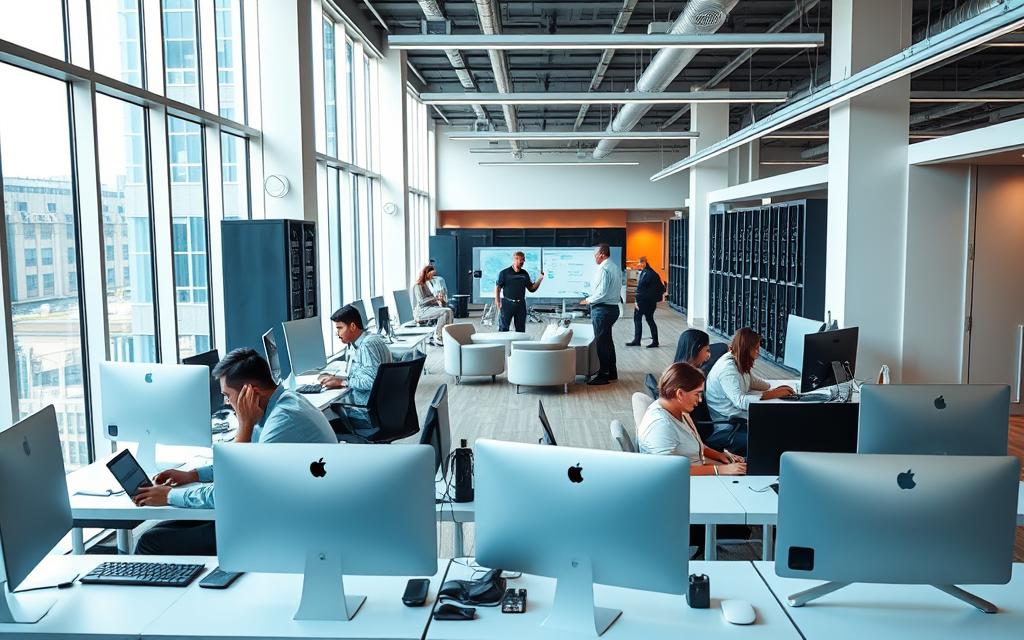
Remote Work: The New Normal
Hybrid work models have become the standard, blending in-office and remote work environments. Studies show that flexible schedules boost productivity by 13%, as employees can better balance personal and professional commitments. Coworking spaces are also on the rise, with utilization rates increasing by 25% in urban areas.
Digital nomad visa programs are gaining traction worldwide, allowing professionals to work from anywhere. Countries like Portugal and Estonia offer incentives to attract remote workers, fostering global talent mobility.
Automation and Job Displacement: The Future of Employment
Robotic Process Automation (RPA) is transforming industries, with 80% of Fortune 500 companies adopting these tools. Amazon’s warehouse robotics, for instance, has streamlined operations, reducing manual labor by 40%. However, this shift raises concerns about job displacement.
Reskilling programs are addressing this challenge, with success rates averaging 70% across industries. Tools like GitHub Copilot are enhancing developer productivity, enabling faster coding and innovation. Yet, the integration of AI surveillance tools in employee monitoring has sparked debates about privacy and ethics.
“The future of work lies in balancing innovation with human-centric approaches.”
As we navigate this evolving landscape, understanding the impact of automation and remote work is crucial. By leveraging these advancements responsibly, we can create a more inclusive and efficient workplace.
The Role of AI in Shaping the Future
Artificial intelligence is rapidly transforming industries and reshaping the future. From healthcare to finance, AI is driving innovation and efficiency. According to Tech.co, 47% of companies are considering AI over hiring, highlighting its growing importance.
GPT-4’s performance on professional certification exams demonstrates its capabilities. It has scored in the 90th percentile, showcasing its potential as a powerful tool. However, detecting AI-generated content remains a challenge, with accuracy rates hovering around 70%.
ChatGPT and Beyond: The AI Revolution
DeepMind’s AlphaFold has revolutionized drug discovery, predicting protein structures with unprecedented accuracy. This breakthrough underscores the potential of AI in scientific research. Quantum computing is also enhancing AI capabilities, with synergy research showing promising results.
Ethical Considerations: The Dark Side of AI
The EU AI Act’s risk classification framework aims to address ethical concerns. Case studies reveal biases in hiring algorithms, raising questions about fairness. AI watermarking is emerging as a solution to ensure transparency in content creation.
“Balancing innovation with ethical considerations is crucial for the responsible development of AI.”
Successful regulation models worldwide highlight the importance of proactive measures. As AI continues to evolve, understanding its impact on the future is essential for harnessing its potential responsibly.
Technology and Social Inequality
Access to technology is not universal, creating a divide that affects millions worldwide. While some enjoy high-speed internet and cutting-edge tools, others struggle with basic connectivity. This digital divide exacerbates existing social inequality, limiting access to education, healthcare, and economic opportunity.

According to the ITU, 60% of the global population lacks broadband access. This disparity is particularly stark in rural areas, where infrastructure is often inadequate. Initiatives like Starlink are bridging this gap by providing satellite internet to remote communities, but challenges remain.
The Digital Divide: Access and Opportunity
In many regions, limited access to technology hinders progress. For example, smartphone-only internet users face restrictions in accessing essential services. This reliance on mobile devices often excludes them from full participation in the digital economy.
India’s Aadhaar biometric ID system has shown promise in improving access to government services. However, concerns about privacy and data security persist. Blockchain solutions are emerging as a way to enhance financial inclusion, offering secure and transparent transactions for underserved communities.
Bridging the Gap: Technology as a Tool for Equity
Digital literacy programs are proving effective in empowering individuals. Metrics show that participants gain essential skills, improving their opportunity for employment and education. Yet, gender gaps in STEM education remain a barrier, particularly in developing nations.
Assistive technologies are also advancing, providing new opportunities for people with disabilities. Public-private partnerships are driving innovation, ensuring that these tools reach those who need them most.
“Technology has the power to level the playing field, but only if we address the digital divide and ensure equitable access for all.”
By leveraging technology responsibly, we can create a more inclusive future. Addressing social inequality requires collaboration, innovation, and a commitment to bridging the gap.
The Environmental Impact of Technology
The environmental footprint of modern advancements is a growing concern. While innovation drives progress, it also poses significant challenges to our planet. From e-waste to energy consumption, the ecological consequences of technology demand urgent attention.
E-Waste: The Hidden Cost of Innovation
In 2023, the world generated 53.6 million metric tons of e-waste, according to the Global E-Waste Monitor. This staggering figure highlights the hidden cost of rapid technological obsolescence. Discarded devices often contain toxic substances like lead and mercury, posing risks to ecosystems and human health.
Recycling rates for rare earth elements remain low, exacerbating the problem. Urban mining projects, however, are showing promise. These initiatives recover valuable materials from discarded electronics, reducing the need for new resource extraction.
The EU’s right-to-repair legislation is a step forward. By encouraging longer device lifespans, it aims to curb e-waste generation. Apple’s carbon neutrality roadmap also sets an example, focusing on sustainable production and recycling.
Sustainable Tech: A Greener Future
Efforts to mitigate the environmental impact of technology are gaining momentum. Hydrogen fuel cell data centers are emerging as a cleaner alternative to traditional energy-intensive facilities. These innovations reduce greenhouse gas emissions while maintaining efficiency.
The Internet of Things (IoT) is optimizing energy use in smart grids. Sensors monitor and control resource consumption, enhancing sustainability. Biodegradable electronics research is another breakthrough, offering eco-friendly alternatives to conventional components.
Cryptocurrency mining, however, remains a challenge. Its energy consumption trends are alarming, prompting calls for greener solutions. Blockchain technology, though, is being leveraged to improve transparency in supply chains and promote ethical sourcing.
“Sustainable innovation is not just a choice—it’s a necessity for a healthier planet.”
For more insights on the environmental impact of technology, explore this detailed analysis.
The Future of Technology: What Lies Ahead
The trajectory of technological advancements is reshaping the future in unprecedented ways. From emerging technologies to ethical considerations, the next decade promises transformative changes. According to Tech.co, 50% of large companies are planning to adopt multiple AI tools, signaling a shift toward intelligent systems.

As we explore what lies ahead, it’s essential to understand both the potential and the challenges. The integration of innovation with humanity will determine how these advancements shape society.
Emerging Technologies: What to Expect
Neuromorphic computing is on the horizon, with commercialization timelines pointing to widespread adoption by 2030. This technology mimics the human brain, offering unparalleled efficiency in processing complex tasks.
Quantum supremacy has already been achieved in controlled environments, with benchmarks suggesting practical applications within the next decade. This breakthrough could revolutionize fields like cryptography and material science.
Brain-computer interfaces are progressing rapidly, with clinical trials showing promising results. These devices could enable direct communication between the brain and external systems, opening new possibilities for healthcare and accessibility.
The Metaverse faces adoption challenges in enterprise settings, but its potential for immersive collaboration remains undeniable. Meanwhile, mRNA vaccine printers are being deployed globally, ensuring rapid response to future health crises.
Fusion energy breakthroughs are anticipated by 2040, offering a clean and virtually limitless power source. Interplanetary internet infrastructure projects are also underway, paving the way for seamless communication across space.
Balancing Innovation and Humanity
As technology advances, ethical considerations become paramount. Ethics committees in tech R&D departments are playing a crucial role in ensuring responsible development. These groups address concerns like data privacy, algorithmic bias, and environmental impact.
The challenge lies in harmonizing innovation with humanity. While cutting-edge tools offer immense potential, their deployment must prioritize societal well-being. Transparent regulations and inclusive design principles are key to achieving this balance.
“The future of technology is not just about what we can create, but how we choose to use it responsibly.”
| Technology | Expected Milestone |
|---|---|
| Neuromorphic Computing | Commercialization by 2030 |
| Quantum Supremacy | Practical applications by 2035 |
| Brain-Computer Interfaces | Widespread adoption by 2040 |
| Fusion Energy | Breakthroughs by 2040 |
By embracing these advancements thoughtfully, we can shape a future where technology enhances lives while respecting the values of humanity.
Conclusion: Navigating the Impact of Technology
As we navigate the complexities of the digital age, understanding its multifaceted impact is crucial. Technology has reshaped society, offering both opportunities and challenges. To harness its benefits, a balance between innovation and well-being is essential.
Actionable steps include setting screen time limits, promoting digital literacy, and fostering mindful usage. Policymakers must address ethical concerns, ensuring emerging technologies prioritize people’s welfare. Successful digital wellness programs, like Common Sense Education, demonstrate the power of informed adoption.
Both individuals and institutions share the responsibility to create a healthier digital ecosystem. Next-generation digital citizenship education will equip people with the skills to thrive in the future. By adopting a cautious yet optimistic approach, we can ensure technology enhances lives without compromising our values.


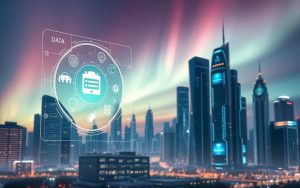
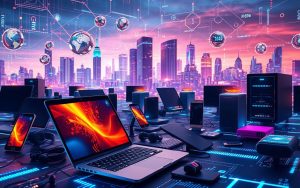
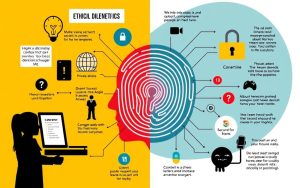



Great blog you’ve got here.. It’s difficult to find excellent writing like yours these days. I seriously appreciate individuals like you! Take care!! http://www.kayswell.com